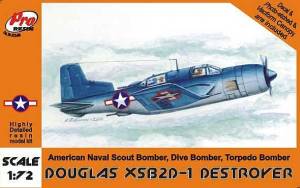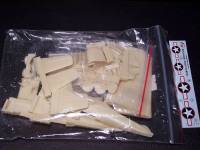Pro Resin 1/72nd Douglas XSB2D-1 "Destroyer"
|
 |
History
Although
the XSB2D-1 Destroyer embodied much of the experience gained by Douglas
with their SBD Dauntless series of shipboard bombers, it was, in fact,
an entirely new design bearing virtually no resemblance to its predecessor.
Intended as a heavy shipboard attack aircraft, the XSB2D-1 made its debut
in 1942, the first two prototypes having the BuAer serial numbers 03551
and 03552. It embodied a number of advanced features, not least of which
was the provision of remotely-controlled dorsal and ventral gun barbettes
each containing a single 0.5-in. machine gun with 800 rounds. Fixed armament
comprised two wing-mounted 20-mm. cannon with 400 rounds.
Powered by a Wright Cyclone R-3 350-14
radial air-cooled engine offering a maximum output of 2,250 h.p. for take-off
and a normal maximum of 1,800 h.p. at 6,800 ft., the XSB2D-1 had an empty
weight of 12,458 lb. and a maximum loaded weight of  19,825
lb. Overall dimensions were: span, 45 ft. 0 in.; span folded, 20 ft. 8
in.; length, 38 ft. 7 in.; height, 16 ft. 1 in.; wing area, 375 sq. ft.
The fuselage bomb-bay could accommodate two 500-lb., 1,000-lb., or 1,600-lb.
bombs, two 325-lb. or 650-lb. depth charges, or two Mk. 13-1 or, 2 torpedoes,
and two 100-lb. bombs or 325-lb. depth charges could be carried on underwing
pylons. Performance was as follows: maximum speed, 321 m.p.h. at sea level,
320 m.p.h. at 7,500 ft. 346 m:p.h. at 16,100 ft.; initial climb rate (at
16,273 lb.). 1,940 ft./min. (at 19,825 lb.) 1,150 ft./min.; time to 10.000
ft. (at 16,273 lb.), 6.3 min., (at 19,825 lb.), 12.6 min.; service ceiling
(maximum loaded weight), 20,300 ft.; range (at 16,273 lb.), 850 mIs. at
180 m.p.h., (at 19,825 lb.). 620 mls. at 177 m.p.h. 19,825
lb. Overall dimensions were: span, 45 ft. 0 in.; span folded, 20 ft. 8
in.; length, 38 ft. 7 in.; height, 16 ft. 1 in.; wing area, 375 sq. ft.
The fuselage bomb-bay could accommodate two 500-lb., 1,000-lb., or 1,600-lb.
bombs, two 325-lb. or 650-lb. depth charges, or two Mk. 13-1 or, 2 torpedoes,
and two 100-lb. bombs or 325-lb. depth charges could be carried on underwing
pylons. Performance was as follows: maximum speed, 321 m.p.h. at sea level,
320 m.p.h. at 7,500 ft. 346 m:p.h. at 16,100 ft.; initial climb rate (at
16,273 lb.). 1,940 ft./min. (at 19,825 lb.) 1,150 ft./min.; time to 10.000
ft. (at 16,273 lb.), 6.3 min., (at 19,825 lb.), 12.6 min.; service ceiling
(maximum loaded weight), 20,300 ft.; range (at 16,273 lb.), 850 mIs. at
180 m.p.h., (at 19,825 lb.). 620 mls. at 177 m.p.h.
An evaluation batch of thirteen SB2D-1s
was ordered (BuAer Nos. 04959-04971), and a further prototype was completed
(BuAer No. 44318), but prior to the completion of these aircraft they
were redesignated as BTD-1. Destroyers. The prototypes being redesignated
XBTD-1s. The third prototype and the pre-production Destroyers differed
from the initial prototypes in having the remotely-controlled gun barbettes
eliminated, together with the position for the second crew member, this
resulting in some cockpit redesign. The first pre-production BTD-1 Destroyer
(04959) appeared in December 1943, this later being modified as the sole
XBTD-2 and a further fourteen BTD-1s were ordered (BuAer Nos. 09048-09062),
but only the first three of these were completed before further development
of the Destroyer was cancelled.
The Kit
 Pro
Resin, produced by Pro Resin Models, has released three new kits, the
XSB2D-1, BTD-1 Destroyer, and the XBTD-2. This particular review will
be about the first, yet all three should be similar since they are based
upon the same general airframe. Pro
Resin, produced by Pro Resin Models, has released three new kits, the
XSB2D-1, BTD-1 Destroyer, and the XBTD-2. This particular review will
be about the first, yet all three should be similar since they are based
upon the same general airframe.
The kit came in a sturdy two piece tray
box. Fifty-two light cream resin pieces, a photo-etch sheet and a single
vacu-form canopy were stuffed into two, resealable plastic bags. The resin
parts were clean with no mold release that I could find. They had some
air bubbles, though nothing too bad that Mister Surfacer can't fix. The
fuselage parts had some nice side-wall detail molded in for the rear compartment,
though there is none in the cockpit itself, this will mostly be filled
up by the cockpit tub. There is some flash on all the parts, so when you
build this craft, test fit all the main components (fuselage, wings, etc.)
before gluing anything. The parts aren't lavishly detailed, but there
is just enough detail to satisfy most of us in the true and manly scale.
The
instructions are printed on a single double-sided sheet. Disregard the
history printed at the beginning since I believe this is a mix of information
from their previous release of the XF15C-1 and the real information of
the XSB2D-1. The instructions are shown in five steps. The drawings are
fairly simple to follow and don't pose any problems in construction. The
instructions don't mention the need for weight to be added, but the distance
between the rear wheels and the tail highly suggest the need for some.
The two-part illustration is really basic, I suggest using the box illustration
as your main painting guide.
 The
decals give you only one option, none of which has the serial numbers
of the two prototypes. The
decals give you only one option, none of which has the serial numbers
of the two prototypes.
The Photo-etch sheet consists of dive
brakes, cockpit panels and bits, belts, oleo struts and cowling flaps.
These, I think, hit the essential requirements for this kit.
There
are some down-sides to this model though. The wheels are crudely shaped,
not truly circular in the wheel hubs. You will have to do some artful
gluing to hide some of the defects. It would be better to replace the
wheels altogether if you can find replacements. The landing gear looks
fragile, especially the front one. Its multi-part construction looks too
weak to handle the weight. There is only one vacu-form canopy, so be careful
when cutting this one out.
Conclusion
 As
far as I know, this is the only XSB2D-1 being produced today. This kit
is recommended for those who have built a few resin kits already. Despite
its few shortcomings, this kit looks like it can be built up into an impressive
model. As
far as I know, this is the only XSB2D-1 being produced today. This kit
is recommended for those who have built a few resin kits already. Despite
its few shortcomings, this kit looks like it can be built up into an impressive
model.
My thanks to Pro Resin for this
review kit.
References
|
|
